Nikon D750 vs D7500 – what's the difference?
In the Nikon D750 vs D7500 DSLR head-to-head the cameras sound the same – but the similar names prove deceptive!
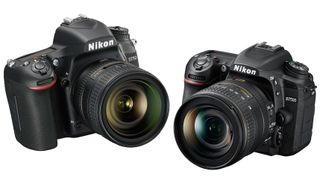
In this Nikon D750 vs Nikon D7500 comparison guide we help you pick the best option from the two great DSLR cameras in the Nikon range – and help you find the best price.
When it comes to electronic gadgets, there’s a propensity for us to seek out the latest and greatest, perhaps forgetting the fact that an older DSLR model can not only be snapped up for a bargain price but will still provide years of service. A case in point is the Nikon D750 which, while it may be coming up for a six years since launch, is still a very capable option for photo enthusiasts looking to avoid breaking the bank while making that step up from APS-C sensor to full frame DSLR photography. Plus, the fact that this full frame DSLR is longer in the tooth than most may ensure that there are some great-value deals to be grabbed on this very capable all rounder – and is one of the cheapest full-frame cameras around.
Of course the major difference between the numerically similar D750 and the newer D7500 is that while the former utilizes a full frame sensor, the D7500 makes use of a smaller standard APS-C chip, meaning the need for its users to seek out lenses compatible with Nikon’s DX format camera mount. Despite the smaller sensor in the D7500 however, both DSLRs can be confidently classed as enthusiast targeted cameras.
The 24.3MP resolution of the full frame Nikon D750 may be relatively modest compared with 40 megapixel beasts higher up the range, but most will find that resolution suits their purposes just fine. By contrast the APS-C sensor Nikon D7500 pumps out a slightly reduced 20.9MP effective resolution.
• Read more: Best lenses for the Nikon D750
Being a full frame camera, the Nikon D750 utilizes Nikon’s full frame format ‘FX’ camera mount – with, again, a specific array of directly compatible lenses required. Many Nikon F-mount lenses will fit on both of these cameras – although some will be suited better to one better than the other. DX lenses are designed for exclusive use of DX cameras like the D7500 - and these are typically wide-angle zooms or all-in-one superzooms.
The smaller sensor of the D7500 means that there is a 1.5x 'crop factor' to take into account when comparing lenses. So a 50mm lens on a D750 gives an equivalent focal length of 50mm, but the same lens used on a D7500 will give a slightly more telephoto view with a 75mm equivalent focal length.
• See also Nikon D750 vs D850 • Nikon D780 vs D750
• Nikon D750 vs D610 vs D810 • Nikon Z50 vs D7500
Whichever you choose, with the Nikon D750 and the Nikon D7500 you’ll be getting a very capable camera. But to help you make that initial selection between the two, we’ve provided a slew of comparisons in terms of specification and expert opinion to help tip the balance in your own mind one way or the other…
Nikon D750 vs D7500: sensor
Why you can trust Digital Camera World
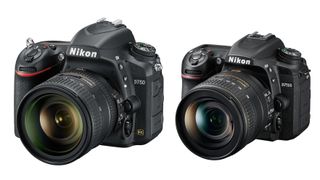
Nikon D750: 24.3 megapixel Full frame (FX format) CMOS sensor (35.9x24mm) and EXPEED 4 processor
Nikon D7500: 20.9 megapixel APS-C (DX format) CMOS sensor (23.5x15.7 mm) and EXPEED 5 processor
The distinct advantage the D750 has here is its offering of full frame sensor photography. This means the size of its ‘chip’ is the same as that of a frame of 35mm film and that the focal length given on any attached lens will be what you get in actuality. It also ensures that, in theory, image quality will be noticeably better than that achievable with a standard (smaller) APS-C sensor DSLR like that offered by the D7500 – especially when combined with directly compatible full frame format lenses.
The D750 offers an effective resolution of 24.3 megapixels from its sensor – perfectly respectable for most intended purposes that the camera would be put to. This is coupled with an EXPEED 4 processor that keeps things zipping along and affords the higher frame rates when shooting video in particular. That said, this processor is neither as new, or its top frame rate as fast, as those offered by the D7500.
The 20.9 megapixel sensor in the D7500 is also a solid option for a semi pro DSLR, as it borrows a bunch of technology from Nikon’s D500. However we not only get a physically smaller sensor by direct comparison to the D750 but also a slightly lower resolution with it. More positively, this option does boast 4K video capture with it, so it’s not all yesterday’s news by any means. Ditto the fact that this model features the next generation of processor when compared to the D750; named the EXPEED 5. Plus, our original review pointed out that we got a great performance from the D7500’s sensor, which has enabled a good high ISO light sensitivity range.
Full reviews: Nikon D750 • Nikon D7500
Nikon D750 vs D7500: video
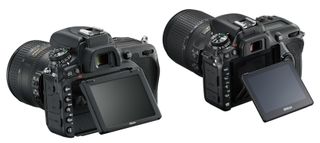
Nikon D750: Full HD 1920x1080 pixels at up to 59.94fps
Nikon D7500: 4K at up to 30fps
The Nikon D750 DSLR offers the possibility of shooting Full HD resolution video at up to an actual maximum frame rate of 59.94fps, as opposed to 4K video capture offered by more up-to-date DSLR alternatives - such as the Nikon D7500 it’s being directly compared with here, which does offer the newer 4K option, being the first in Nikon’s non professional DSLR series to do so.
Nevertheless, on the D750 we get stereo microphone and headphone ports, which videographers will certainly appreciate. Alternatively, if using the built-in microphone, a setting can be applied which reduces wind noise when filming. The tilting LCD screen on the D750 – and on the D7500 too – is another definite advantage when composing video, and a light sensitivity range from ISO100 up to 51200 equivalent can also be accessed in this mode.
On top of this it could be argued that, when it comes to the D750, most amateur photographers will be perfectly happy with Full HD capture - even if the option of 4K on the Nikon D7500 does suggest it’s slightly more ‘future proofed’ because of having this feature.
As well as the option of 4K resolution video, the D7500 can shoot Full HD resolution video at up to 60P. Videographers may grumble that just the one card slot is provided on the camera, however, which suggests this is perhaps not the ideal model for power users.
Nikon D750 vs D7500: Burst shooting
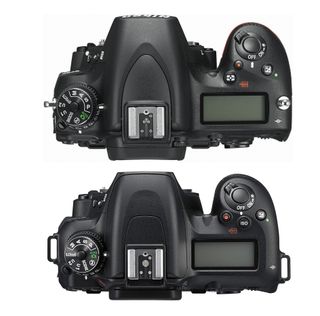
Nikon D750: Up to 6.5fps
Nikon D7500: Up to 8fps
As both the D750 and D7500 are intended to be ‘all rounders’ for shooting a variety of subjects, there are cameras that offer a better frame rate if you’re prepared to spend more than you would do on these general-purpose offerings. That being said, let’s see what’s on offer here.
The Nikon D750 is capable of shooting up to a respectable 6.5fps in continuous shooting mode, which is fair for this class of camera and, while it isn’t quite top-of-the-range, nevertheless makes it suitable for both occasional sports and wildlife photography.
On paper at least for action photographers the lower down the range D7500 would seem to be the preferred option – especially if they don’t need the top class resolution that the D750 bestows – as it offers up to 8fps shooting. Battery life is good for 950 shots too, which suggests this APS-C DSLR as a good option for a visit to the sports field.
Nikon D750 vs D7500: AF system
Nikon D750: 51 point autofocus system
Nikon D7500: 51 point autofocus system
The Nikon D750 offers a highly proficient 51-point AF (auto focus) system with very reliable metering to boot.
Though it may offer the smaller sensor and lower resolution, the D7500’s AF system remains fairly advanced however, matching the D750 with 51 points, here with 15 cross type, even if we found focusing when in Live View mode to be a little sluggish in our original review. It does however come with the Group Area AF mode found in Nikon’s professional models and an Auto AF Fine Tune feature.
Nikon D750 vs D7500: Viewfinder/LCD
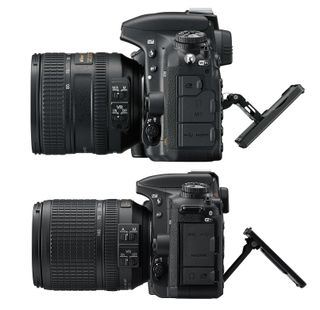
Nikon D750: Eye level pentaprism single lens reflex viewfinder offering 100% frame coverage; 3.2-inch LCD with 1,229,000 dot resolution
Nikon D7500: Eye level pentaprism single lens reflex viewfinder offering 100% frame coverage; 3.2-inch LCD with 922K dots resolution
Offering an eye level pentaprism type viewfinder, the Nikon D750 supplements this with a 3.2-inch tilting LCD screen at the rear, which was a first for an FX format DSLR at the time. The monitor’s high resolution of over 1.2 million dots delivers a life-like image when composing and reviewing shots in Live View mode, whether using the camera in stills capture or video mode. Of course the alternative is to utilise the DSLR’s eye level optional viewfinder to compose images, with the need, naturally, to refer back to said LCD screen to review what has been captured.
The Nikon D7500 again offers the traditional eye level pentaprism optical viewfinder, which here commendably offers 100% coverage, so what you see is what you get. At the back it further offers the bonus of a tilting angle 3.2-inch LCD screen. This is also a touch screen, so, although resolution is slightly les than that of the D750, users can have the facility to direct the camera’s focus by tapping the subject directly on screen.
Nikon D750 vs D7500: build
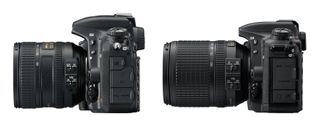
Nikon D750: Polycarbonate construction, 840g
Nikon D7500: Carbon fiber construction, 720g
Aimed at both the enthusiast and the professional on a budget, the commendably weather-sealed D750 offers that familiar Nikon DSLR look and feel that will enable any photographer to pick up and start using this camera straight away if they’ve been used to handling DSLRs either lower down or further up the range.
The D750 control layout also feels a lot more approachable than that of an outright professional DSLR, should that also cause you pause for thought. Nikon claims that its kevlar/carbon fibre composite shutter has been road tested up to 150,000 releases, while the camera’s ‘monocoque’ – meaning ‘single shell’ – construction aids durability.
Given its semi pro class, the D750 weighs a relatively lightweight 840g. Its dimensions measure a ‘trim’ 140.5x113x78mm.
Like the D750, the alternative in the D7500 also features a single shell ‘monocoque’ construction. With a carbon fibre rather than metal alloy build, it’s also weather sealed for use in the great outdoors and construction quality feels good. With marginally more compact dimensions of 136x104x73mm, it’s also a lighter weight 720g, body only including battery and memory card.
Nikon D750 vs D7500: other features
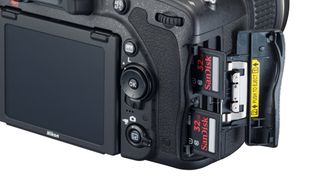
On the D750 we get various effects modes, including the ability to combine two shots to achieve High Dynamic Range imagery. Time lapse functions, two card slots (SDXC and UHS-I compatible) plus built in Wi-Fi for connecting to your other smart devices (as likewise offered by the D7500) further the D750’s overall usability. It may not offer 4K video capability of the Nikon D7500, but then it’s hardly a lightweight in terms of its own overall feature set.
We liked the fact that the D7500 offers a top plate window enabling the user to glance at and alter key settings in a thrice. Bluetooth and Wi-Fi is also accessible on this newer camera, while it features a top light sensitivity setting of a fairly spectacular ISO1,640,000.
Nikon D750 vs D7500: battery life
Nikon D750: Up to 1230 frames per charge of its EN-EL15 rechargeable lithium ion battery
Nikon D7500: Up to 950 frames per charge of its EN-EL15a rechargeable lithium ion battery
Very respectable is the performance given by the D750 in conjunction with its own EN-EL15 cell, in being able to eke out up to 1230 images from a full charge.
Still impressive but slightly less so by comparison is the 950 images achievable from a full charge of the D7500’s own battery, the EN-EL15a. Still, this is very much top of the tree when it comes to the sort of performance we’d expect from a consumer DSLR camera battery.
Nikon D750 vs D7500: Verdict

Full frame DSLRs aimed at high end enthusiasts and professional photographers usually cost a fair amount more than smaller sensor, more obviously consumer orientated APS-C DSLRs. But with the full frame Nikon D750 being positively ancient at the time of writing it can be snapped up for a price very close to what a newer APS-C DSLR would cost you. We therefore have a choice. Instead of going for the latest, should we not go for the greatest?
Yes, the Nikon D750 has been around for a while now, but, arguably, that means that users have had more time to appreciate its all round versatility and creative flexibility. It’s still an appealing and cost effective DSLR for those photography enthusiasts seeking to make the step up to full frame capture - as long as they don’t mind the fact that, for video, ‘just’ Full HD video capture is offered here, rather than the latest and greatest 4K.
But as regards the D7500, if you can live with its smaller APS-C sized sensor and marginally lower resolution compared with the D750, then this is a camera with which you cannot go far wrong. It offers 51 point auto focus, a tilting touch screen at its rear, 4K video capture and a fairly similar experience to using the D750.
All that being said, the D750 still represents something of a bargain for those looking to make the step up to full frame photography without causing a run on the bank.
How we test cameras
We test DSLR cameras both in real-world shooting scenarios and in carefully controlled lab conditions. Our lab tests measure resolution, dynamic range and signal to noise ratio. Resolution is measured using ISO resolution charts, dynamic range is measured using DxO Analyzer test equipment and DxO Analyzer is also used for noise analysis across the camera's ISO range. We use these real-world testing and lab results to inform our comments in buying guides. For compact cameras and phones, we judge on real world handling and photographic results alone.
Read more
Best beginners cameras
Get the Digital Camera World Newsletter
The best camera deals, reviews, product advice, and unmissable photography news, direct to your inbox!
Gavin has over 30 years’ experience of writing about photography and television. He is currently the editor of British Photographic Industry News, and previously served as editor of Which Digital Camera and deputy editor of Total Digital Photography.
He has also written for a wide range of publications including T3, BBC Focus, Empire, NME, Radio Times, MacWorld, Computer Active, What Digital Camera and the Rough Guide books.
With his wealth of knowledge, Gavin is well placed to recognize great camera deals and recommend the best products in Digital Camera World’s buying guides. He also writes on a number of specialist subjects including binoculars and monoculars, spotting scopes, microscopes, trail cameras, action cameras, body cameras, filters and cameras straps.
